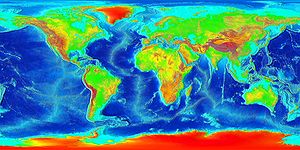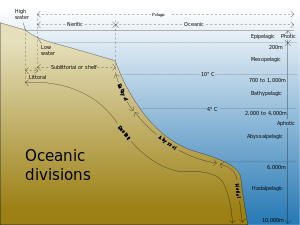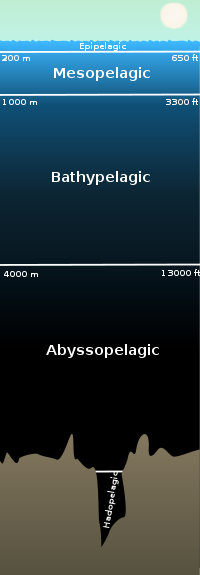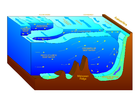- Seabed
-
This article is about ocean floor. For the 2001 song by Audio Adrenaline, see Lift (Audio Adrenaline album).
 Map showing the underwater topography (bathymetry) of the ocean floor. Like land terrain, the ocean floor has ridges, valleys, plains and volcanoes.
Map showing the underwater topography (bathymetry) of the ocean floor. Like land terrain, the ocean floor has ridges, valleys, plains and volcanoes.
The seabed (also known as the seafloor, sea floor, or ocean floor) is the bottom of the ocean.
Contents
Ocean structure
Most of the oceans have a common structure, created by common physical phenomena, mainly from tectonic movement, and sediment from various sources. The structure of the oceans, starting with the continents, begins usually with a continental shelf, continues to the continental slope - which is a steep descent into the ocean, until reaching the abyssal plain - a topographic plain, the beginning of the seabed, and its main area. The border between the continental slope and the abyssal plain usually has a more gradual descent, and is called the continental rise, which is caused by sediment cascading down the continental slope.
The mid-ocean ridge, as its name implies, is a mountainous rise through the middle of all the oceans, between the continents. Typically a rift runs along the edge of this ridge. Along tectonic plate edges there are typically oceanic trenches - deep valleys, created by the mantle circulation movement from the mid-ocean mountain ridge to the oceanic trench.
Hotspot volcanic island ridges are created by volcanic activity, erupting periodically, as the tectonic plates pass over a hotspot. In areas with volcanic activity and in the oceanic trenches, there are Hydrothermal vents - releasing high pressure and extremely hot water and chemicals into the typically freezing water around it.
The ocean water is divided into layers, each with typical features of salinity, pressure, temperature and marine life, according to their depth called Abyssal zones. Lying along the top of the abyssal plain is the abyssalpelagic layer, whose lower boundary lies at about 6,000 metres (20,000 ft). The hadalpelagic - which includes the oceanic trenches, lies between 6,000–11,000 metres (20,000–36,000 ft) and is the deepest oceanic zone.
Seabed features
 Oceanic ridge with deep sea vent
Oceanic ridge with deep sea vent
Each area of the seabed has typical features such as common soil composition, typical topography, salinity of water layers above it, marine life, magnetic direction of rocks, and sedimenting.
Seabed topography is flat where sedimenting is heavy and covers the tectonic features. Sedimenting comes from various sources:
- Land erosion sediments, brought mainly by rivers,
- New "young rock" - New magma of basalt composition, from the mid-ocean ridge.
- Underwater volcanic ash spreading, especially from hydrothermal vents.
- Microorganism activity.
- Sea currents eroding the seabed itself,
- Marine life: corals, fish, algae, crabs, marine plants and other biological created sediment.
Where sedimenting is avoided, such as in the Atlantic ocean especially in the northern and eastern Atlantic, the original tectonic activity can be clearly seen as straight line "cracks" or "vents" thousands of kilometers long.
Recently there has been the discovery of abundant marine life in the deep sea, especially around hydrothermal vents. Large deep sea communities of marine life have been discovered around black and white 'smokers' - hydrothermal vents emitting typical chemicals toxic to humans and most of the vertebrates. This marine life receives its energy from both the extreme temperature difference (typically a drop of 150 degrees) and from chemosynthesis by bacteria.
History of exploration
The seabed has been explored by submersibles such as Alvin and, to some extent, scuba divers with special apparatuses. The process that continually adds new material to the ocean floor is seafloor spreading and the continental slope. In recent years satellite images show a very clear mapping of the seabed, and are used extensively in the study and exploration of the ocean floor.
see History of Oceanography for a full description of the history of ocean exploration, including the seabed.
Technical terms
The acronym "mbsf" meaning "metres below the seafloor" is a convention used for depths below the seafloor.[1][2]
In art and culture
Ancient children's play songs include elements such as "There's a hole at the bottom of the sea", or "A sailor went to sea... but all that he could see was the bottom of the deep blue sea".
See also
References
- ^ Flood, Roger D.; Piper, D.J.W., Klaus, A., and Peterson, L.C. (Eds.) (1997). "Preface: Depth Below Seafloor Conventions". Proceedings of the Ocean Drilling Program, Scientific Results 155: 3. "we follow Ocean Drilling Program (ODP) meters below seafloor (mbsf) convention"
- ^ Parkes, R. John; Henrik Sass (2007). Sulphate-reducing bacteria environmental and engineered systems. Edited by Larry L. Barton University of New Mexico. Cambridge University Press. pp. 329–358. doi:10.1017/CBO9780511541490.012. http://ebooks.cambridge.org/chapter.jsf?bid=CBO9780511541490&cid=CBO9780511541490A018. Retrieved 11 June 2010. "metres below the seafloor (mbsf)"
External links
- Understanding the Seafloor presentation from Cosee – the Center for Ocean Sciences Educational Excellence.
- Ocean Explorer (www.oceanexplorer.noaa.gov) – Public outreach site for explorations sponsored by the Office of Ocean Exploration.
- NOAA, Ocean Explorer Gallery, Submarine Ring of Fire 2006 Gallery, Submarine Ring of Fire 2004 Gallery – A rich collection of images, video, audio and podcast.
- NOAA, Ocean Explorer YouTube Channel
- Submarine Ring of Fire, Mariana Arc – Explore the volcanoes of the Mariana Arc, Submarine Ring of Fire.
- "Age of the ocean floor poster". NOAA. March 7, 2007. http://www.soest.hawaii.edu/GG/ASK/plate-tectonics2.html. Retrieved 2007-03-14.
- Astonishing deep sea life on TED (conference)
Categories:- Oceanography
- Fisheries science
- Oceanography stubs
Wikimedia Foundation. 2010.




